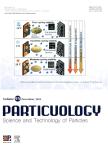Bubbling behavior of cohesive particles in a two-dimensional fluidized bed with immersed tubes
Bubbling behavior of cohesive particles in a two-dimensional fluidized bed with immersed tubes作者机构:Key Laboratory of Energy Thermal Conversion and Control of Ministry of Educotion School of Energy and Environment Southeast University Nanjing 210096 China
出 版 物:《Particuology》 (颗粒学报(英文版))
年 卷 期:2017年第15卷第2期
页 面:152-160页
核心收录:
学科分类:07[理学]
主 题:Fluidized bed Cohesive particle Immersed tube Bubble behavior
摘 要:Fluidization hydrodynamics are greatly influenced by inter-particle cohesive forces. This paper studies the fluidization of large cohesive particles in a two-dimensional fluidized bed with immersed tubes using “polymer coating to introduce cohesive force, to gain better understanding of bubbling behavior when particles become cohesive and its effect on chemical processes. The results show that the cohesive force promotes bubble splitting in the tube bank region, thereby causing an increase in the number and a decline in the aspect ratio of the bubbles. As the cohesive force increases within a low level, the bubble number increases and the bubble diameter decreases, while the aspect ratio exhibits different trends at different fluidization gas velocities. The difference in the evolution of bubble size under various cohesive forces mainly takes place in the region without tubes. When the cohesive force is large enough to generate stable agglomerates on the side walls of the bed, the bubble number and the bed expansion sharply decrease. The tubes serve as a framework that promotes the agglomeration, thus accelerating defluidization. Finally, the bubble profile around tubes was studied and found to greatly depend both on the cohesive forces and the location of tubes.



